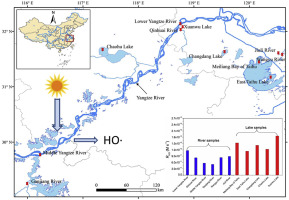当前位置:
X-MOL 学术
›
Water Res.
›
论文详情
Our official English website, www.x-mol.net, welcomes your feedback! (Note: you will need to create a separate account there.)
Photogeneration and steady-state concentration of hydroxyl radical in river and lake waters along middle-lower Yangtze region, China.
Water Research ( IF 12.8 ) Pub Date : 2020-04-01 , DOI: 10.1016/j.watres.2020.115774 Huacheng Xu 1 , Yani Li 2 , Jin Liu 3 , Haiyan Du 1 , Yingxun Du 1 , Yaling Su 1 , Helong Jiang 1
Water Research ( IF 12.8 ) Pub Date : 2020-04-01 , DOI: 10.1016/j.watres.2020.115774 Huacheng Xu 1 , Yani Li 2 , Jin Liu 3 , Haiyan Du 1 , Yingxun Du 1 , Yaling Su 1 , Helong Jiang 1
Affiliation

|
Hydroxyl radical (HO∙) in natural waters plays a critical role in contaminant transformation and ecosystem health. In this study, the photogeneration and steady-state concentration of HO∙ in different aquatic environments (e.g., river and lake) along the middle-lower Yangtze region, China, were evaluated. The results showed that, compared to lake samples, the river waters were characterized by lower HO∙ photoformation rate (RHO∙) (5.10-11.69 × 10-11 vs. 1.10-1.82 × 10-10 M s-1) and steady-state HO∙ concentration ([HO∙]) (1.76-3.11 × 10-17 vs. 2.50-10.33 × 10-17 M). The contribution of nitrate and nitrite to the total RHO∙ in river waters was generally higher than that in lake waters, and photolysis of nitrite exhibited contributions 1-2 times higher than those of nitrate (0-25% vs. 0-9%) irrespective of sample types. As a result, the photosensitization by chromophoric dissolved organic matter (CDOM) contributed more than 70% of the total RHO∙ for all samples except for River Ganjiang. [HO∙] among all samples was positively correlated with dissolved organic carbon (DOC) concentration, and the DOC-normalized [HO∙] was further related to the physicochemical properties of CDOM samples (e.g., aromaticity, humification, and molecular weight). The humic-like aromatic substances with low molecular weight were the controlling factors influencing [HO∙] in the studied surface waters. The results contributed to a deeper understanding of behaviors and fate of aquatic DOMs in terms of HO∙ formation and contaminant attenuation.
中文翻译:

长江中下游地区江河和湖泊水域中羟基自由基的光生和稳态浓度
天然水中的羟自由基(HO∙)在污染物转化和生态系统健康中发挥着关键作用。在这项研究中,评估了长江中下游地区不同水生环境(例如河流和湖泊)中HO∙的光生和稳态浓度。结果表明,与湖泊样品相比,河水的特征在于较低的HO∙光形成率(RHO∙)(5.10-11.69×10-11对1.10-1.82×10-10 M s-1)和稳定的水。状态HO∙浓度([HO∙])(1.76-3.11×10-17与2.50-10.33×10-17 M)。硝酸盐和亚硝酸盐对河水中总RHO∙的贡献通常高于湖泊水,亚硝酸盐的光解作用比硝酸盐高1-2倍(0-25%比0-9%)不论样本类型如何。结果是,除赣江外,所有样品的发色溶解有机物(CDOM)的光敏作用占总RHO∙的70%以上。所有样品中的[HO∙]与溶解有机碳(DOC)浓度呈正相关,而DOC归一化[HO∙]与CDOM样品的理化特性(例如芳香性,增湿和分子量)进一步相关。低分子量的腐殖质样芳香物质是影响所研究地表水中[HO∙]的控制因素。结果有助于从HO∙形成和污染物衰减方面更深入地了解水生DOM的行为和命运。所有样品中的[HO∙]与溶解有机碳(DOC)浓度呈正相关,而DOC归一化[HO∙]与CDOM样品的理化特性(例如芳香性,增湿和分子量)进一步相关。低分子量的腐殖质样芳香物质是影响所研究地表水中[HO∙]的控制因素。结果有助于从HO∙形成和污染物衰减方面更深入地了解水生DOM的行为和命运。所有样品中的[HO∙]与溶解有机碳(DOC)浓度呈正相关,而DOC归一化[HO∙]与CDOM样品的理化特性(例如芳香性,增湿和分子量)进一步相关。低分子量的腐殖质样芳香物质是影响所研究地表水中[HO∙]的控制因素。结果有助于从HO∙形成和污染物衰减方面更深入地了解水生DOM的行为和命运。低分子量的腐殖质样芳香物质是影响所研究地表水中[HO∙]的控制因素。结果有助于从HO∙形成和污染物衰减方面更深入地了解水生DOM的行为和命运。低分子量的腐殖质样芳香物质是影响所研究地表水中[HO∙]的控制因素。结果有助于从HO∙形成和污染物衰减方面更深入地了解水生DOM的行为和命运。
更新日期:2020-04-01
中文翻译:

长江中下游地区江河和湖泊水域中羟基自由基的光生和稳态浓度
天然水中的羟自由基(HO∙)在污染物转化和生态系统健康中发挥着关键作用。在这项研究中,评估了长江中下游地区不同水生环境(例如河流和湖泊)中HO∙的光生和稳态浓度。结果表明,与湖泊样品相比,河水的特征在于较低的HO∙光形成率(RHO∙)(5.10-11.69×10-11对1.10-1.82×10-10 M s-1)和稳定的水。状态HO∙浓度([HO∙])(1.76-3.11×10-17与2.50-10.33×10-17 M)。硝酸盐和亚硝酸盐对河水中总RHO∙的贡献通常高于湖泊水,亚硝酸盐的光解作用比硝酸盐高1-2倍(0-25%比0-9%)不论样本类型如何。结果是,除赣江外,所有样品的发色溶解有机物(CDOM)的光敏作用占总RHO∙的70%以上。所有样品中的[HO∙]与溶解有机碳(DOC)浓度呈正相关,而DOC归一化[HO∙]与CDOM样品的理化特性(例如芳香性,增湿和分子量)进一步相关。低分子量的腐殖质样芳香物质是影响所研究地表水中[HO∙]的控制因素。结果有助于从HO∙形成和污染物衰减方面更深入地了解水生DOM的行为和命运。所有样品中的[HO∙]与溶解有机碳(DOC)浓度呈正相关,而DOC归一化[HO∙]与CDOM样品的理化特性(例如芳香性,增湿和分子量)进一步相关。低分子量的腐殖质样芳香物质是影响所研究地表水中[HO∙]的控制因素。结果有助于从HO∙形成和污染物衰减方面更深入地了解水生DOM的行为和命运。所有样品中的[HO∙]与溶解有机碳(DOC)浓度呈正相关,而DOC归一化[HO∙]与CDOM样品的理化特性(例如芳香性,增湿和分子量)进一步相关。低分子量的腐殖质样芳香物质是影响所研究地表水中[HO∙]的控制因素。结果有助于从HO∙形成和污染物衰减方面更深入地了解水生DOM的行为和命运。低分子量的腐殖质样芳香物质是影响所研究地表水中[HO∙]的控制因素。结果有助于从HO∙形成和污染物衰减方面更深入地了解水生DOM的行为和命运。低分子量的腐殖质样芳香物质是影响所研究地表水中[HO∙]的控制因素。结果有助于从HO∙形成和污染物衰减方面更深入地了解水生DOM的行为和命运。


























 京公网安备 11010802027423号
京公网安备 11010802027423号